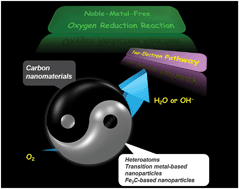Towards high-efficiency nanoelectrocatalysts for oxygen reduction through engineering advanced carbon nanomaterials
Abstract
One of the critical issues in the industrial development of fuel cells (e.g., proton exchange membrane fuel cells, direct methanol fuel cells and biofuel cells) is the high cost, serious intermediate tolerance, anode crossover, sluggish kinetics, and poor stability of the platinum (Pt) as the preferred electrocatalysts for the oxygen reduction reaction (ORR) at the cathode. The development of novel noble-metal-free electrocatalysts with low cost, high activity and practical durability for ORR has been considered as one of the most active and competitive fields in chemistry and materials science. In this critical review, we will summarize recent advances on engineering advanced carbon nanomaterials with different dimensions for the rational design and synthesis of noble-metal-free oxygen reduction electrocatalysts including heteroatom-doped carbon nanomaterials, transition metal-based nanoparticle (NP)–carbon nanomaterial composites and especially the stable iron carbide (Fe3C)-based NP–carbon nanomaterial composites. Introducing advanced carbon nanomaterials with high specific surface area and stable structure into the noble-metal-free ORR field has not only led to a maximized electrocatalyst surface area for the electron transfer but also resulted in enhanced electrocatalyst stability for long-term operation. Therefore, the rational design and synthesis of noble-metal-free electrocatalysts based on heteroatoms, transition metal-based NPs and Fe3C-based NP functionalized carbon nanomaterials are of special relevance for their ORR applications, and represents a rapidly growing branch of research. The demonstrated examples in this review will open new directions on designing and optimizing advanced carbon nanomaterials for the development of extremely active and durable earth-abundant cathodic catalysts for fuel cell applications.



 Please wait while we load your content...
Please wait while we load your content...